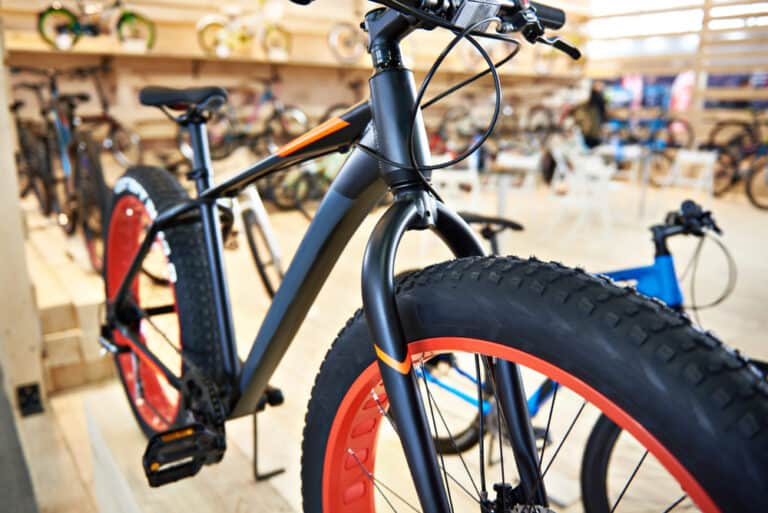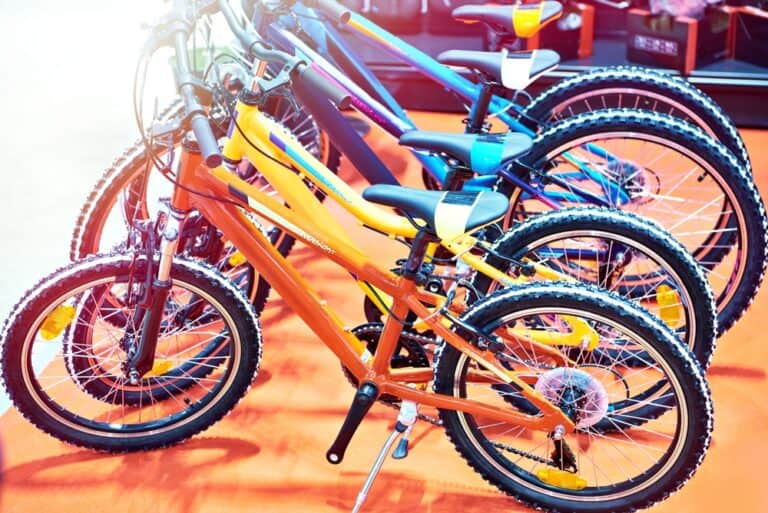How Fast Can You Go Downhill On A Road Bike?

Speeding downhill with the wind howling in your ears and the tires humming away underneath you on a road bike can be one of a cyclist’s most exciting and scariest experiences. The first thought in your head might be how fast am I going, and the second, how fast can I go downhill on my road bike?
The maximum unaided speed (or terminal speed) theoretically obtainable for a road bike on a downhill is 80.8 mph (130 kph). The most significant contributing factor limiting how fast you can go downhill on a road bike is wind resistance (or wind drag) and your weight.
The quest for more speed is always on most cyclists’ bucket lists. Straining uphill is made bearable with the knowledge that there will soon be a downhill section where one can rest while freewheeling down. But how fast can you go while cycling downhill on a road bike, and what are the limitations to doing so?
How Fast Can You Cycle Down A Hill On A Road Bike?
The maximum speed (or terminal velocity) achievable while cycling downhill varies greatly between cyclists. The fastest theoretical unassisted speed going downhill is about 80.8 mph (130 kph). Many variables determine the terminal velocity obtainable on a downhill ride, with gravitational forces (think mass) and air resistance being the main ones.
How Does Gravity Influence Downhill Speed On A Road Bike?
Cyclists that weigh more will have higher terminal velocities, and this can be explained by looking at the physics involved. Gravity is the attraction force that exists between two objects. The bigger an object, the larger the gravitational pull it exerts on other things surrounding it (in this case, the earth and the cyclist).
A cyclist on a perfectly level road will experience only the downward component of the acting gravitational force and, therefore, will not benefit from it. This situation will only change when the ground is not level anymore. On a downward slope, the gravitational force will pull the cyclist downhill, thus causing an increase in the speed going downhill or slowing the cyclist down when going uphill.
Does Air Resistance Affect Speed When Riding Downhill?
The steeper the slope (or gradient), the bigger the acceleration down the hill will be. So the question then is, what stops the cyclist from accelerating downhill uncontrollably? To answer the question, let us look at the effect air resistance has on the cyclist’s forward movement.
At low speeds, air resistance is not a significant factor. However, as you pick up speed, you will feel the wind becoming more noticeable on your face. The wind can be so intense at very high velocities to push your unsecured bike helmet up and over your head!
The wind resistance force works against the gravitational force. At some point, these forces will cancel each other out, and the net result for the cyclist is a constant speed while going downhill (elegantly called terminal velocity).
What Can Be Done To Go Faster Downhill On A Road Bike?
Air resistance is one of the most significant factors limiting downhill speed. The cycling fraternity has done much research in clothing and bike design to reduce the effects of air resistance. Every slight improvement made can add up to many seconds throughout a race.
Redesigned Cycling Clothes To Reduce Wind Resistance
The invention of the skin-tight cycling suit is the most significant breakthrough in cycling in many years. The cycling clothes of yesteryear consisted mainly of loose-fitting wool shirts and standard cycling shorts fitted with deerskin padding. The effectiveness of vintage cycling clothes is far from the modern one-piece lycra (spandex or elastane) suit with its aerodynamic grooves and figure-hugging design.
Another design improvement has made cycling shoes more aerodynamic. Today it is possible to purchase specially made latex shoe covers that fit over standard cycling shoes. These covers smooth out the shoe’s shape to improve the airflow over the shoe, reducing wind drag.
The standard cycling helmet’s only function is to protect your head. Upgrading to a more aerodynamic helmet will help you to gain more than sixty seconds over a twenty-five mile (forty km) distance while traveling at an average of eleven miles per hour (eighteen kph). The downside of an aerodynamic helmet is that it is heavier and much hotter because of reduced airflow.
Improved Road Bike Design For Faster Downhill Speeds
The bicycle makes up about 30% of the wind resistance experienced on a road bike. It stands to reason that a bike design that reduces drag will be faster. Aerodynamic improvements include making the frame tubes less round (tear shaped) and reshaping the handlebars to reduce wind drag.
Introducing disc brakes has made it possible to redesign the bicycle frame to improve wind flow. The racing bicycle wheel has been designed with fever spokes and a bigger rim depth to cope with structural demands. Once a popular item on road bikes, solid disc wheels have been relegated to indoor cycling events due to severe handling issues when encountering crosswinds.
Does Body Posture Affect Downhill Speed On A Road Bike?
The most significant contributor to wind drag is the cyclist. Besides wearing tight-fitting clothes, reducing the frontal size of the cyclist is essential. Competitive cyclists always try to position themselves as low as possible on their bikes. One such position is where the cyclist lies prone on the top tube of the bicycle frame.
The Dangers Lurking In High-Speed Descends On A Road Bike
Any cyclist can tell you things can get hair-raising while barreling down a hill. There is less reaction time, and the bike becomes more sensitive to the slightest directional input, such as crosswinds. The adrenalin factor starts to compete with the fear factor, and things go crazy after that.
As the speed increases, the smoothness of the road surface becomes seriously important. The slightest bump or pothole can have disastrous consequences. Loose gravel around a corner or even a solitary stone can cause a wipeout. It is a good idea to check the road conditions before venturing down a hillside at speed.
Unless the road you are using is blocked off, you will not be alone on that road. Stray animals (birds included), other cyclists, and cars can cause great excitement around blind corners.
It is also advisable to wear some eye protection while cycling, especially at high speeds. Many cyclists can share a story of a random bug hitting them in the face, mouth, or eye during a cycling trip. The faster you go, the more severe the impact on your face.

Conclusion
The fastest speed that is reachable while freewheeling down a hillside is in the region of 80.8 mph (130 kph) without the aid of wind from behind or a tow draft. The terminal speed varies between riders due to many variables, such as weight, air resistance, the aerodynamics of the cycling gear, and environmental factors.
References
- https://youtu.be/8Zm0nHUH21Q
- https://www.answers.com/physics/Why_do_you_go_faster_down_a_steeper_incline
- https://youtu.be/khzDJZ2Z5ow
- https://www.britannica.com/technology/bicycle/Bicycle-design
- https://www.cyclist.co.uk/tutorials/4345/how-to-increase-your-average-speed-in-the-new-year
- https://tiptar.com/what-are-cycling-shoe-covers-and-what-are-they-for/
- https://tiptar.com/the-importance-of-aerodynamics-in-cycling/
- https://www.sportsci.org/jour/9804/dps.html
- https://www.exploratorium.edu/cycling/aerodynamics1.html
- https://en.wikipedia.org/wiki/Bicycle_wheel#Disc_wheels







